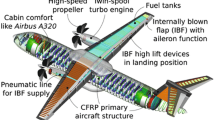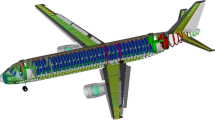Abstract
The wing of an active high lift aircraft configuration with an UHBR engine is structurally sized. The FEA details droop nose and flaps and uses loads from 3D CFD RANS simulations for the fully stressed design. The sizing yields a comparable skin thickness distribution compared to a similar wing configuration with a Turboprop engine. The differences in mass result mainly from the relatively high UHBR engine weight and the higher sweep angle. Furthermore the steady aeroelastic equilibrium is computed with a partitioned approach for the landing configuration at optimal circulation control. Flow separation is initiated at the end of the unprotected leading edge, propagating to the outboard main wing and aileron. The effect of the wing elasticity onto the aerodynamics is negligible due to the high stiffness of the UHBR configuration.
Access this chapter
Tax calculation will be finalised at checkout
Purchases are for personal use only
Similar content being viewed by others
References
Radespiel, R., Heinze, W.: SFB 880: Fundamentals of high lift for future commercial aircraft. CEAS Aeronaut. J. 5(3), 239–251 (2014). https://doi.org/10.1007/s13272-014-0103-6
Griffin Jr, R.N., Holzhauser, C.A., Weiberg, J.A.: Large-scale wind-tunnel tests of an airplane model with an unswept, aspect-ratio-10 wing, two propellers, and blowing flaps. Technical report (1958)
Deal, P., Grunwald, K.J., Hall, A.: Flight investigation of performance characteristics during landing approach of a large powered-lift jet transport. Technical report (1967)
Innis, R.C., Holzhauser, C.A., Quigley, H.C.: Airworthiness considerations for stol aircraft. Technical report (1970)
Heinze, W., Österheld, C. M., Horst, P.: Multidisziplinäres Flugzeugentwurfsverfahren PrADO—Programmentwurf und Anwendung im Rahmen von Flugzeug-Konzeptstudien. Deutsche Gesellschaft für Luft-und Raumfahrt (DGLR), vol. 3, pp. 1701–1712, Bonn (2001)
Young, T.: Outlines of experiments and inquiries respecting sound and light. Philos. Trans. R. Soc. Lond. 90, 106–150 (1800)
Lighthill, M.: Notes on the deflection of jets by insertion of curved surfaces, and on the design of bends in wind tunnels. Reports and memoranda 2105, Aeronautics Research Council (1945)
Korbacher, G.: Aerodynamics of powered high-lift systems. Ann. Rev. Fluid Mech. 6(1), 319–358 (1974). https://doi.org/10.1146/annurev.fl.06.010174.001535
Wood, N.: Circulation control airfoils—past, present, future. Technical report 85-0204, AIAA (1985). https://doi.org/10.2514/6.1985-204
Sommerwerk, K., Haupt, M.: Design analysis and sizing of a circulation controlled CFRP wing with Coandă flaps via CFD-CSM coupling. CEAS Aeronaut. J. 5(1), 95–108 (2014). https://doi.org/10.1007/s13272-013-0093-9
Sommerwerk, K., Michels, B., Haupt, M.C., Horst, P.: Influence of engine modeling on structural sizing and approach aerodynamics of a circulation controlled wing. CEAS Aeronaut. J. 9(1), 219–233 (2018). https://doi.org/10.1007/s13272-018-0290-7
Sommerwerk, K., Michels, B., Lindhorst, K., Haupt, M.C., Horst, P.: Application of efficient surrogate modeling to aeroelastic analyses of an aircraft wing. Aerosp. Sci. Technol. 55, 314–323 (2016)
Sommerwerk, K., Krukow, I., Haupt, M., Dinkler, D.: Investigation of aeroelastic effects of a circulation controlled wing. AIAA J. Aircr. (Advance online publication), 1–11 (2016). https://doi.org/10.2514/1.C033780
Neuert, N., Dinkler, D.: Aeroelastic behaviour of a parameterised circulation-controlled wing. CEAS Aeronaut. J. 10(3), 955–964 (2019). https://doi.org/10.1007/s13272-018-0348-6
Neuert, N., Dinkler, D.: Aeroelastic behaviour of a wing with over-the-wing mounted uhbr engine. In: Deutscher Luft- und Raumfahrtkongress (2019)
Keller, D., Rudnik, R.: Configurational aspects of a circulation controlled high-lift system for a medium-haul transport aircraft In: Deutscher Luft- und Raumfahrtkongress 2019 DocumentID 490128
Haas, D., Chopra, I.: Static aeroelastic characteristics of circulation control wings. J. Aircr. 25(10), 948–954 (1988). https://doi.org/10.2514/3.45684
Schwamborn, D., Gardner, A., von Geyr, H., Krumbein, A., Lüdecke, H.: Development of the DLR TAU-code for aerospace applications. In: Proceedings of the International Conference on Aerospace Science and Technology, pp. 26–28. Bangalore, India (2008)
Spalart, P., Allmaras, S.: A one-equation turbulence model for aerodynamic flows. AIAA Paper 92–0439, (1992). https://doi.org/10.2514/6.1992-439
Puck, A., Schürmann, H.: Failure analysis of frp laminates by means of physically based phenomenological models. Compos. Sci. Technol. 58(7), 1045–1067 (1998)
Haupt, M., Niesner, R., Unger, R., Horst, P.: Computational aero-structural coupling for hypersonic applications. In: 9th AIAA/ASME Joint Thermophysics and Heat Transfer Conference, pp. 5–8 (2006). https://doi.org/10.2514/6.2006-3252
Rendall, T., Allen, C.: Efficient mesh motion using radial basis functions with data reduction algorithms. J. Comput. Phys. 228(17), 6231–6249 (2009). https://doi.org/10.1016/j.jcp.2009.05.013
Sommerwerk, K.: Isogeometrische Analyse für die Optimierung von Leichtbaustrukturen im Flugzeugbau. TU Braunschweig—Niedersächsisches Forschungszentrum für Luftfahrt, 2017. Doctoral dissertation
Acknowledgements
The authors gratefully acknowledge the funding as part of the Coordinated Research Centre 880 provided by the German Research Foundation (Deutsche Forschungsgemeinschaft-DFG).
The computations were performed with resources provided by the North-German Supercomputing Alliance (HLRN).
The DLR-TAU computations have been set up with the help of Dennis Keller from Institute of Aerodynamics and Flow Technology, German Aerospace Center, Brunswick.
Author information
Authors and Affiliations
Corresponding author
Editor information
Editors and Affiliations
Rights and permissions
Copyright information
© 2021 The Editor(s) (if applicable) and The Author(s), under exclusive license to Springer Nature Switzerland AG
About this chapter
Cite this chapter
Runge, F., Sommerwerk, K., Rohdenburg, M., Haupt, M.C. (2021). Design of Active High Lift Wing Configurations Via Fluid-Structure Interaction Simulation. In: Radespiel, R., Semaan, R. (eds) Fundamentals of High Lift for Future Civil Aircraft. Notes on Numerical Fluid Mechanics and Multidisciplinary Design, vol 145. Springer, Cham. https://doi.org/10.1007/978-3-030-52429-6_13
Download citation
DOI: https://doi.org/10.1007/978-3-030-52429-6_13
Published:
Publisher Name: Springer, Cham
Print ISBN: 978-3-030-52428-9
Online ISBN: 978-3-030-52429-6
eBook Packages: EngineeringEngineering (R0)




